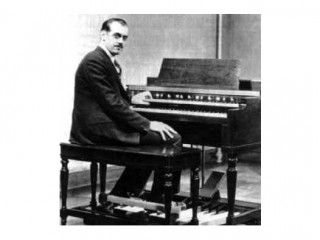
Laurens Hammond biography
Date of birth : 1895-01-11
Date of death : 1973-07-03
Birthplace : Evanston, Illinois,U.S.
Nationality : American
Category : Science and Technology
Last modified : 2011-10-04
Credited as : Inventor, Hammond organ, Novachord
1 votes so far
His patent for the Hammond organ was granted on 24 April 1934. Feuded with Donald James Leslie over his invention of the Leslie speaker. Held 110 patents.
Laurens studied mechanical engineering at Cornell University and was a member of the Delta Upsilon fraternity. He graduated with an honors degree in 1916. At this time most thoughts were concentrated on the ongoing World War I, and Laurens made his contribution to the war effort serving his time with the 16th Regiment Engineers (Railway) American Expeditionary Force in France.
Following this, he moved to Detroit, where he was fortunate to occupy the post of chief engineer of the Gray Motor Company, a manufacturer of marine engines. In 1919, he invented a silent spring-driven clock. This invention brought Laurens enough money to leave Gray Motor Company and rent his own space in New York.
In 1922, Hammond invented the Teleview system of shutter glasses in association with 3-D films. One feature was made for the system, a film called Radio-Mania, that year. Hammond premiered his show at the Selwyn Theatre in New York City in December 1922 to major critical success, but the economics of installing the expensive machinery in the theater prematurely killed the project's success.
In 1928, Hammond founded the Hammond Clock Company, after designing a synchronous clock motor that was inspired by Henry Warren's Telechrons, but was not self-starting. Hammond's clock business ran into difficulties in the early 1930s, and he struggled to save his business through a number of other inventions, such as an electric bridge table and, slightly later, his famous organ.
In 1933, he bought a used piano and proceeded to discard everything apart from the actual keyboard action. Using this piano keyboard as a controller, he was able to experiment with various different sound generating methods until he found the best one-the tonewheel generator. The company's assistant treasurer, W. L. Lahey, was the organist at the nearby St. Christopher's Episcopal Church, and so Laurens consulted with him during the design process and sought feedback on the quality of the new instrument's sound. With all his previous manufacturing and engineering experience, the tonewheel generator was incredibly well engineered by the time the organ finally went into production. The number of tonewheel organs still in regular use is a testament in itself to the quality of the original design and execution of the product.
Laurens filed his patent on January 19, 1934. At this time, unemployment was a major problem due to the Great Depression, and with this in mind, the patents office rushed to grant Hammond's application, with the hope of creating job opportunities in the area.
He was awarded the Franklin Institute's John Price Wetherill Medal in 1940 for the invention of the Hammond electric organ.
















